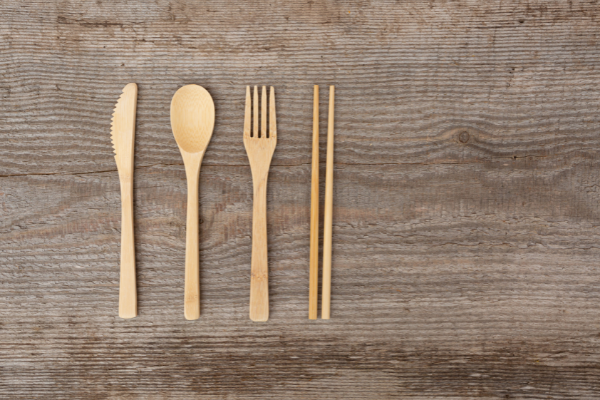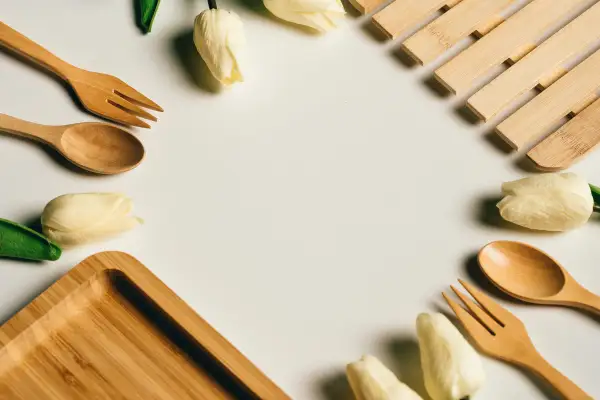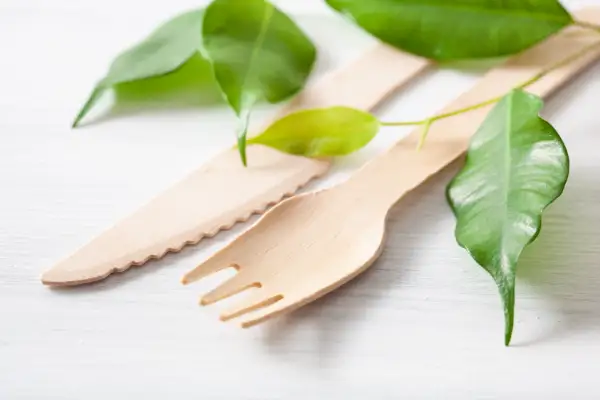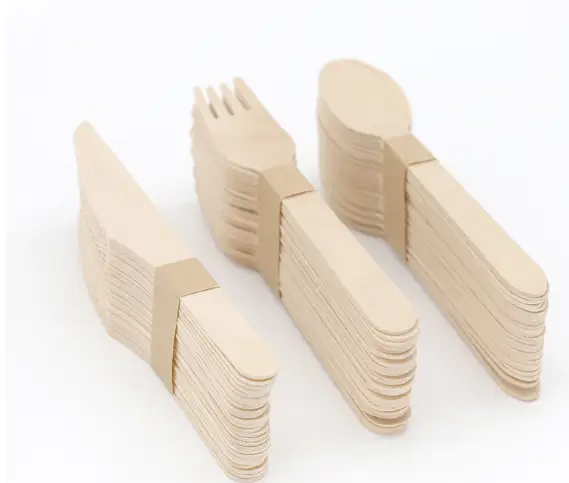Wooden Cutlery: The Ultimate FAQ Guide 2022
If you're looking for wooden cutlery and want to know what it is, then this article is for you.
What is wooden cutlery?

Wooden cutlery is a type of cutlery made out of wood. Typically, it's made to be a disposable alternative to plastic or metal cutlery. Unlike plastic, wooden cutlery doesn't have to be washed (because it's disposable). It also doesn't include any harmful chemicals or dyes like those found in plastic or metal cutlery.
How wooden cutlery is it made?

Wooden cutlery is made from natural wood. No toxic, chemical or latex finishes are applied to the product's surface. These utensils can be used for both hot and cold foods, so they are perfect for virtually any application.
Wooden cutlery has a smooth surface and rounded edges. They are comfortable for your customers to use. Wooden cutlery does not have a rough texture that can cause splinters or other problems. When you order our wooden tableware, you will receive a high-quality, premium product that is safe and healthy for your customers to use when eating their meal.
The wooden utensil is made from renewable wood sources like birch and maple wood. When you purchase these utensils, you are helping to support the environment by using renewable resources instead of non-renewable resources like plastic derived from fossil fuels.
Wooden cutlery and wooden tableware items are disposable, which means they can be thrown away after use instead of being rewashed in a dishwasher or sink. This dramatically reduces the amount of water consumed by your restaurant or business, making it much more efficient than reusable items like metal or plastic flatware.
What kind of wood is wooden cutlery used?

Wooden cutlery is a type of disposable utensils made from various types of wood, including birch and poplar. The handles tend to be more like the traditional smooth, rounded shape of wooden utensils in most cases. However, unlike traditional wooden spoons and forks, these disposable utensils are not made with metal or plastic components.
This lack of metal or plastic makes them very lightweight and easy to clean. You can wash them in hot soapy water or rinse them with a damp cloth. They also require very little maintenance after each use. All you need to do is occasionally wipe them down with a damp cloth and then dry them thoroughly before putting them back into the dishwasher for another round of cleaning.
Most people enjoy using wooden cutlery because the handle feels very comfortable in their hands. It also provides a nice grip without feeling too rough on their skin. Some people will use it for everyday use at home because it is convenient and easy to care for. Suppose you want to get one for yourself. In that case, there are several different styles available that you can choose from depending on what your specific needs are.
Is wooden cutlery food safe?
Yes, wooden cutlery is food safe because the wood is treated with heat to ensure sanitarily. The heat treatment kills off bacteria and germs, making it as safe for you to use as any other type of cutlery.
Are there alternatives to wooden cutlery?
Wooden cutlery is the most common option for disposable, environmentally friendly flatware. However, several other options can be more affordable and better for the environment.
Paper Cutlery
Paper cutlery is lighter than wooden cutlery, requiring less energy to transport. It also requires fewer resources to produce. While paper cutlery is recyclable, it cannot be composted, so it ultimately ends up in a landfill like plastic.
Compostable Plastic
Plastic that is made from plants instead of petroleum is considered compostable. It can be used the same way as plastic cutlery, but it will break down completely in a composting system. Compostable plastic can take between 60 and 90 days to decompose completely in an industrial composting facility, while wooden cutlery takes 3 and 5 years. Compostable plastics are sometimes more expensive than wood alternatives because they require more production resources.
About the History of Wooden Cutlery
Many people are unaware that the oldest wood utensils date back to the 14th century. They were first used by the Gajapathi Kings and later were used by the Vijayanagara emperors. The use of wooden cutlery declined dramatically during the reign of the Vijayanagara, but it remained popular among the Jagirs and Nawabs. The history of wooden cutlery also reveals that it became a popular product during the Muslim period. The Muslim rulers made cutlery an integral occupation and visited the Udaygiri forests to gather wood. This was later made famous as "Udaygiri Cutlery."
Despite the widespread use of wooden cutlery, it was considered unfavorable in the past. The spores are invisible to the naked eye, but they can easily spread through the air. Consequently, wooden cutlery can be a hotbed for mold. While this is not a practical option, many people still find wooden cutlery attractive. This article will provide you with some historical background about the history of wooden cutlery.
Before the invention of the silverware forks, diners used primitive wooden cutlery. Today, wood cutlery is widely used in many countries. Its attractive appearance and aesthetics make it a favorite among many people. Its environmental benefits have also made it a desirable option for consumers. With its low carbon footprint and renewable resource content, wooden cutlery is an excellent choice for those concerned about the environment.
A common misconception about wooden cutlery is that it is not recyclable. The consumer can reuse wooden cutlery. However, the wooden material can become contaminated by mold if left out in the open. Because wooden cutlery is made from wood, it can be easily recycled or donated. The wooden material is also biodegradable. In addition to its aesthetic value, wood is also more sustainable than metal.
The history of Wooden Cutlery is rich in history and is considered to be an environmentally friendly material. It is 100% compostable, a green alternative to plastic cutlery. The wood is also beautiful and is not affected by water or other substances. Moreover, it can be reused and donated. The wooden material is also biodegradable. If you are worried about the risks of using wooden cutlery, you can always purchase a set of bamboo or birch.
Before the introduction of plastic cutlery, diners used primitive wooden cutlery. In modern times, it was replaced by the silverware fork. But the use of plastic cutlery increased the number of non-biodegradable materials. Since wooden cutlery is made of wood, it is more environmentally friendly. It is durable and is made of renewable resources. That means that you can use wooden cutlery in a more environmentally-friendly manner.
Is Wooden Cutlery Eco-friendly?
The answer is a resounding "yes." Not only is wooden cutlery environmentally friendly, but it also looks more modern. The material is 100% natural, without plastics or other harmful chemicals. It is also aesthetically appealing and gives your food a classy look. In addition, it is nontoxic. Here are some reasons why you should opt for wood cutlery.

First, wood is biodegradable. Making wood utensils uses less energy than the production of plastic, which results in less CO2 in the atmosphere. Unlike plastic, wood doesn't create toxic emissions into the environment, so you can safely toss it after use and forget about it. In addition, you can recycle it and use it over again.
Second, it's a great choice for those who want to make their home more sustainable. The most common type of wood for cutlery is oak, maple, or cherry. It's the most expensive option, but it's worth it. It can be composted and can be manufactured without the use of chemicals. Besides, wood is highly porous and absorbent so that it won't harbor bacteria or water from food.
If you're a minimalist, you can opt for disposable wooden cutlery. They're perfect for outdoor events and zero-waste parties. They're completely biodegradable, and you can throw them away after using them. Another advantage of wooden cutlery is that you can buy it individually or in sets, according to your needs and budget. They're available in different shapes and sizes.
Biodegradable materials are made from plants or other renewable resources, such as bamboo. They are less durable than plastic and produce less pollution than their plastic counterparts. In addition to being biodegradable, wood cutlery is also recyclable. Because it is more sustainable than plastic, it uses less energy in the manufacturing process. You can also buy bamboo cutlery at a supermarket or online.
Wooden cutlery is recyclable and compostable. It is made from sustainable materials such as bamboo and birch. It's also biodegradable, which doesn't contain any harmful chemicals. Some types of wood can be recycled into new wooden cutlery. A good wood-based material may also be more expensive, but it's more environmentally friendly. The main benefit is that it's not as expensive as plastic or metal.
The most environmentally-friendly type of wood-based cutlery is reusable. It's the most eco-friendly option because it's made from birch wood and doesn't require additional additives during the manufacturing process. This type of wood will decompose within three months, making it a green alternative to plastic. However, it's more expensive than plastic. If you're concerned about environmental impact, it's better to opt for bamboo-based products.
While we can't be sure what the future holds for wooden cutlery, it's fair to say that this niche product is grabbing the attention of consumers, chefs, and environmentalists. It will be interesting to see how it continues to grow going forward. One thing is certain: whether you choose to use wooden utensils or not, it's clear that this form of cutlery is here to stay.







